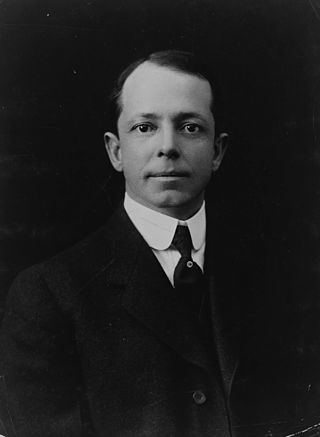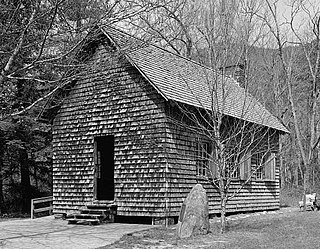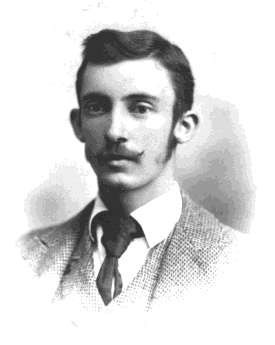
Gifford Pinchot was an American forester and politician. He served as the fourth chief of the U.S. Division of Forestry, as the first head of the United States Forest Service, and as the 28th governor of Pennsylvania. He was a member of the Republican Party for most of his life, though he joined the Progressive Party for a brief period.

A forester is a person who practises forestry, the science, art, and profession of managing forests. Foresters engage in a broad range of activities including ecological restoration and management of protected areas. Foresters manage forests to provide a variety of objectives including direct extraction of raw material, outdoor recreation, conservation, hunting and aesthetics. Emerging management practices include managing forestlands for biodiversity, carbon sequestration and air quality.

Sir Dietrich Brandis was a German-British botanist and forestry academic and administrator, who worked with the British Imperial Forestry Service in colonial India for nearly 30 years. He joined the British civil service in Burma in 1856, shortly afterwards became head of the British forestry administration in all of Burma, and served as Inspector General of Forests in India from 1864 to 1883. He returned to Europe in 1883, dividing his time between Bonn and Greater London. In retirement he dedicated himself to scholarly work, resulting in the book Indian Trees (1906), his magnum opus. Brandis is considered the father of tropical forestry and has also been described as the father of scientific forestry. In addition to his work in India, he also had a significant influence on forest management in the United States.

Charles Sprague Sargent was an American botanist. He was appointed in 1872 as the first director of Harvard University's Arnold Arboretum in Boston, Massachusetts, and held the post until his death. He published several works of botany. The standard botanical author abbreviation Sarg. is applied to plants he identified.

Bernhard Eduard Fernow was the third chief of the USDA's Division of Forestry of the United States from 1886 to 1898, preceding Gifford Pinchot in that position, and laying much of the groundwork for the establishment of the United States Forest Service in 1905. Fernow's philosophy toward forest management may be traced to Heinrich Cotta's preface to Anweisung zum Waldbau or Linnaeus' ideas on the "economy of nature." Fernow has been called the "father of professional forestry in the United States."

Yale School of the Environment (YSE) is a professional school of Yale University. It was founded to train foresters, and now trains environmental students through four 2-year degree programs, two 10-month mid-career programs, and a 5-year PhD program. Still offering forestry instruction, the school has the oldest graduate forestry program in the United States.

Henry Solon Graves was a forest administrator in the United States. He co-founded the Yale Forest School in 1900, the oldest continuous forestry school in the United States. He was appointed Chief of the United States Forest Service in 1910 and served in this position until 1920.

Hosmer's Grove is an example of experimental forestation from Hawaii's territorial days. Located just inside Haleakala National Park near the summit of Haleakala in Maui, Hawaii, it includes a campsite and several hiking trails. The grove is well known amongst birdwatchers due to the abundance of endemic honeycreepers at the site, including Iiwi, Apapane, Hawaii Amakihi, and the Maui Alauahio.
The Maryland Forest Service in 1996 marked the 90th anniversary of forestry in Maryland, United States and the birth of what is known as the Department of Natural Resources Forest Service. Although the service has been known by many names over nine decades, its mission has been consistent: "To conserve and enhance the quality, quantity, productivity and biological diversity of the forest and tree resources of Maryland."

Grey Towers National Historic Site, also known as Gifford Pinchot House or The Pinchot Institute, is located just off US 6 west of Milford, Pennsylvania, in Milford Township. It is the ancestral summer home of Gifford Pinchot, first chief of the newly developed United States Forest Service (USFS) and twice elected governor of Pennsylvania.
Carl Alwin Schenck was a German forester and pioneering forestry educator. When Schenck came to the United States to work for George W. Vanderbilt at the Biltmore Estate, he became the third formally trained forester in the United States. He established and operated the Biltmore Forest School, the first forestry school in North America, on Vanderbilt's property.

The Biltmore Forest School was the first school of forestry in North America. Carl A. Schenck founded this school of "practical forestry" in 1896 on George W. Vanderbilt's Biltmore Estate near Asheville, North Carolina. The school grounds are now part of Pisgah National Forest in Transylvania County, North Carolina as the Cradle of Forestry in America, a 6500-acre historic site which features exhibits about forestry and forest conservation history.

The Society of American Foresters (SAF) is a professional organization representing the forestry industry in the United States. Its mission statement declares that it seeks to "advance the science, education, and practice of forestry; to enhance the competency of its members; to establish professional excellence; and, to use the knowledge, skills and conservation ethic of the profession to ensure the continued health and use of forest ecosystems and the present and future availability of forest resources to benefit society". Its headquarters are located in Washington, D.C.
The New York State College of Forestry at Cornell was a statutory college established in 1898 at Cornell University to teach scientific forestry. The first four-year college of forestry in the country, it was defunded by the State of New York in 1903, over controversies involving the college's forestry practices in the Adirondacks. Forestry studies continued at Cornell even after the college's closing.
The New York State College of Forestry, the first professional school of forestry in North America, opened its doors at Cornell University, in Ithaca, New York, in the autumn of 1898., It was advocated for by Governor Frank S. Black, but after just a few years of operation, it was defunded in 1903, by Governor Benjamin B. Odell in response to public outcry over the College's controversial forestry practices in the Adirondacks.
The North Carolina Forest Service, formerly known as the North Carolina Division of Forest Resources is a North Carolina state government agency responsible for providing land management assistance to landowners. The agency's primary responsibility is wildland fire control on all state and privately owned land in North Carolina, United States. The Service was a Division of the N.C. Department of Environment and Natural Resources until July 2011 and is now part of the North Carolina Department of Agriculture and Consumer Services.

William Willard Ashe was an American forester and botanist. He was known as a prolific collector of plant specimens and an early proponent of conservationism in the Southern United States.

William Buckhout Greeley was the third chief of the United States Forest Service, a position he held from 1920 to 1928. During World War I he commanded U.S. Army forest engineers in France, providing Allied forces with the timber necessary for the war effort.

Robert Young Stuart (1883–1933) was the fourth Chief of the United States Forest Service (USFS) of the Department of Agriculture, and was appointed on May 1, 1928, succeeding William B. Greeley. He served as Chief until his death on October 23, 1933.

Frederick Erskine Olmsted, also known as Fritz Olmsted, was an American forester and one of the founders of American forestry. Through his work with the United States Forest Service, Olmsted helped establish the national forest system in the United States and helped train the next generation of Forest Service agents and college professors. He was instrumental in the creation of at least twenty national forests in California and Alaska including the Muir Woods National Monument and Tongass National Forest. He also wrote the Use of National Forest Resources, a foundational Forest Service manual that laid the groundwork for the nation's enduring forest management system, elements of which remain in use today.















